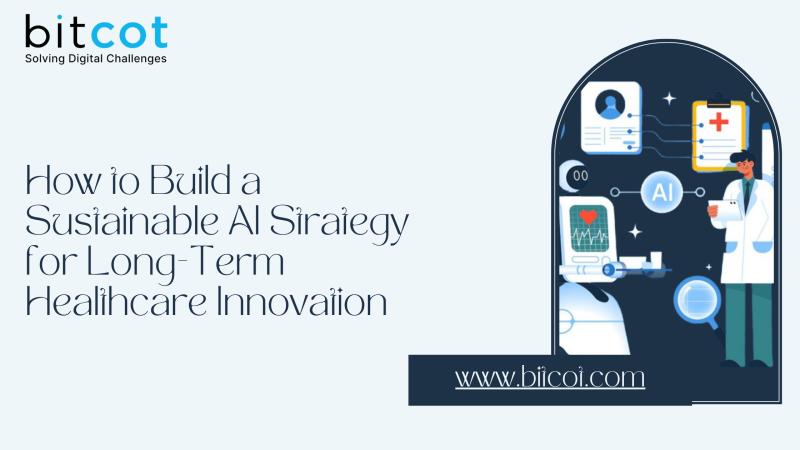How to Build a Sustainable AI Strategy for Long-Term Healthcare Innovation

In recent years, AI has rapidly evolved from a technological novelty to a critical component in advancing healthcare. From predictive diagnostics to operational efficiencies, AI holds the potential to transform every facet of healthcare delivery. However, reaping the long-term benefits of AI requires a well-thought-out strategy that ensures sustainable integration and growth. Here’s how healthcare organizations can build a sustainable AI strategy that fosters long-term innovation and positions them at the forefront of the industry.
1. Define Clear Objectives for AI Integration
The first step in developing a sustainable AI strategy is defining clear, achievable objectives. This involves identifying specific areas within your organization where AI can have the most meaningful impact. Some common AI use cases in healthcare include:
Improving Diagnostics: Utilizing AI for early disease detection and accurate diagnoses.
Optimizing Operations: Using AI-powered automation for administrative tasks to streamline processes.
Enhancing Patient Care: Leveraging AI to personalize treatment plans and improve patient outcomes.
By setting clear objectives, you ensure that AI is integrated with purpose and aligns with your organization’s goals, whether that’s improving patient satisfaction, reducing operational costs, or achieving better diagnostic accuracy.
2. Invest in Data Quality and Infrastructure
A successful AI strategy is only as good as the data driving it. High-quality data is essential for training accurate, reliable AI models. However, in the healthcare field, data quality and privacy are uniquely challenging. Key steps include:
Data Standardization: Ensure that data is consistent, complete, and free from discrepancies across departments. Standardized data leads to more accurate model training and better results.
Data Security and Compliance: Implement robust cybersecurity measures and adhere to healthcare regulations such as HIPAA to protect sensitive patient information.
Infrastructure Investment: Healthcare organizations need infrastructure capable of handling large volumes of data and supporting complex AI algorithms. Cloud-based solutions can help to store and process data efficiently while allowing for scalability.
Investing in data quality and the right infrastructure is crucial for long-term AI effectiveness, as it allows for more accurate insights, better patient outcomes, and more robust compliance with industry regulations.
3. Prioritize a Patient-Centric Approach
An effective AI strategy in healthcare should focus on enhancing patient experiences and outcomes. A patient-centric AI approach requires:
Personalization: AI can analyze patient history and predict individual needs, creating more tailored care plans that resonate with each patient’s unique situation.
Transparency: Make AI processes transparent to patients and their families. Explain how AI tools contribute to diagnosis, treatment, and care recommendations, building trust and understanding.
Privacy and Consent: Respect patients' right to privacy and ensure that they understand how AI will use their data. Obtain informed consent and provide patients with the choice to opt-in or out.
By prioritizing the patient experience and emphasizing transparency, you foster trust in AI technologies, which is vital for their long-term success in healthcare settings.
4. Foster Collaboration Across Departments
For AI to reach its full potential, it must be embraced organization-wide. Collaboration across departments helps ensure AI is adopted in a way that benefits every aspect of the organization, including:
Clinical Staff: Educate clinical staff on how AI tools can assist in patient care, diagnosis, and treatment planning.
IT and Technical Teams: Equip IT teams with training on how to manage and maintain AI systems, ensuring they can troubleshoot and upgrade technology as needed.
Compliance Officers: Involve compliance teams to ensure AI applications adhere to healthcare regulations and mitigate risk.
Cross-departmental collaboration not only helps ensure a smooth AI implementation but also allows your organization to maximize AI’s benefits across different operational and clinical areas.
5. Commit to Continuous Training and Adaptability
AI in healthcare is constantly evolving, with new algorithms, updates, and best practices emerging regularly. To keep your organization’s AI strategy sustainable:
Offer Ongoing Training: Provide regular training sessions for healthcare professionals and technical staff on how to leverage AI tools. This includes introducing new features and updates as they become available.
Encourage a Culture of Adaptability: Promote an environment where staff members are encouraged to innovate and adapt to changes in technology. This mindset fosters continual improvement and smooth transitions when new AI features or applications are introduced.
Emphasize Ethical Considerations: Regular training should also address ethical considerations related to AI, such as biases in data, patient privacy, and informed consent. A culture of ethical awareness contributes to responsible AI use, which is key to building patient trust.
Continuous training and a culture of adaptability ensure that your organization’s AI practices remain up-to-date, effective, and aligned with both technological and ethical standards.
6. Measure and Refine AI Outcomes
Building a sustainable AI strategy requires ongoing evaluation of AI’s effectiveness. Establish key performance indicators (KPIs) to monitor the performance of AI solutions, such as:
Accuracy and Reliability: Track how accurately AI models perform diagnostic or predictive tasks and whether they align with clinical standards.
Efficiency Gains: Assess time and cost savings brought by AI automation in administrative tasks or patient flow management.
Patient Outcomes and Satisfaction: Measure the impact of AI on patient outcomes, satisfaction scores, and overall healthcare experience.
Regularly reviewing these KPIs enables healthcare providers to refine their AI practices and adjust strategies as needed. Monitoring helps address potential issues proactively, such as data biases or unexpected performance discrepancies, ensuring that AI use remains both effective and responsible.
Conclusion Developing a sustainable AI strategy for long-term healthcare innovation requires a structured approach that balances technological advancement with patient-centric care and ethical considerations. By defining clear objectives, investing in data quality, prioritizing patients, fostering collaboration, maintaining adaptability, and continually monitoring AI’s impact, healthcare organizations can effectively harness the power of AI automation in healthcare to deliver high-quality, personalized, and efficient care. With a well-thought-out AI strategy, healthcare providers can position themselves as leaders in innovation, ensuring they are prepared for both the current possibilities and future advancements of AI in healthcare.

Comments